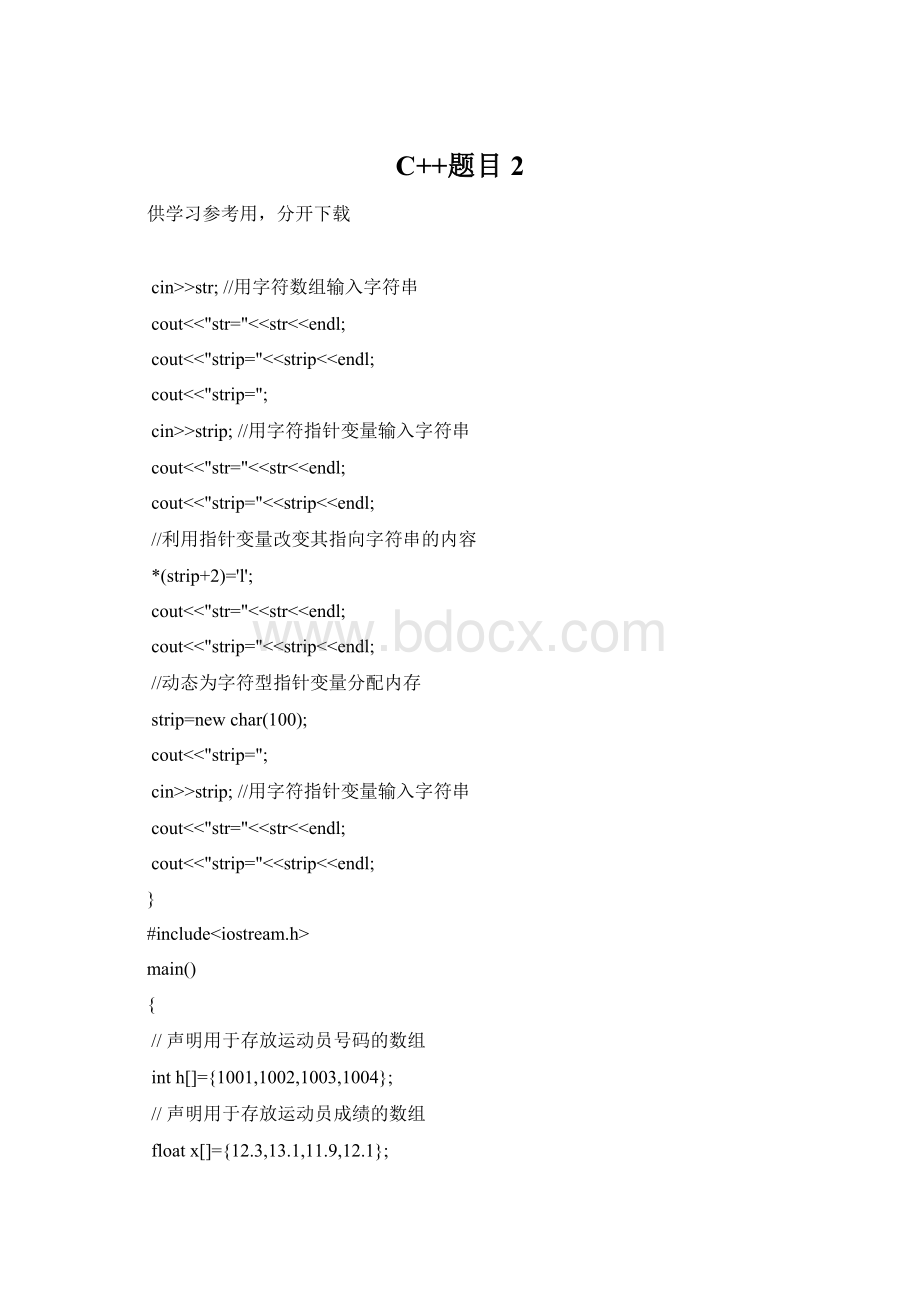 C++题目2.docx
C++题目2.docx
- 文档编号:11568815
- 上传时间:2023-03-19
- 格式:DOCX
- 页数:37
- 大小:23.01KB
C++题目2.docx
《C++题目2.docx》由会员分享,可在线阅读,更多相关《C++题目2.docx(37页珍藏版)》请在冰豆网上搜索。

C++题目2
供学习参考用,分开下载
cin>>str;//用字符数组输入字符串
cout<<"str="< cout<<"strip="< cout<<"strip="; cin>>strip;//用字符指针变量输入字符串 cout<<"str="< cout<<"strip="< //利用指针变量改变其指向字符串的内容 *(strip+2)='l'; cout<<"str="< cout<<"strip="< //动态为字符型指针变量分配内存 strip=newchar(100); cout<<"strip="; cin>>strip;//用字符指针变量输入字符串 cout<<"str="< cout<<"strip="< } #include main() { //声明用于存放运动员号码的数组 inth[]={1001,1002,1003,1004}; //声明用于存放运动员成绩的数组 floatx[]={12.3,13.1,11.9,12.1}; //声明用于存放运动姓名的字符型指针数组 char*p[]={"Wanghua","Zhangjian","Liwei","Huaming"}; //i,j,it是用做循环控制变量和临时变量 inti,j,it; //ft用做暂存变量 floatft; //pt为字符型指针变量用做暂存指针变量 char*pt; //用选择法对数组x进行排序,并相应调整数组h和p中的数据 for(i=0;i<=3;i++) for(j=i+1;j<=3;j++) if(x[i]>=x[j]){ ft=x[i],x[i]=x[j],x[j]=ft; it=h[i],h[i]=h[j],h[j]=it; pt=p[i],p[i]=p[j],p[j]=pt; } //以下打印排序结果 for(i=0;i<=3;i++) cout< } #include main() { //声明指针数组 char*colors[]={"Red","Blue","Yellow","Green"}; //指向指针的指针变量 char**pt; //通过指向指针的变量访问其指向的内容 pt=colors; for(inti=0;i<=3;i++){ cout<<"pt="< cout<<"*pt="<<*pt< cout<<"**pt="<<**pt< pt++; } } #include main() { //定义结构类型 structbooks { chartitle[20]; charauthor[15]; intpages; floatprice; }; //声明结构变量 structbooksZbk={"VC++","Zhang",295,35.5}; booksWbk; //对结构变量的输出 cout<<"Zbk: "< cout< cout< cout< cout< cout<<"--------------------"< //对结构成员的运算 Zbk.pages+=10; Zbk.price+=0.5; cout<<"Zbk.pages="< cout<<"Zbk.price="< cout<<"--------------------"< //对结构变量的输入输出 cout<<"Wbk.title="; cin>>Wbk.title; cout<<"Wbk.author="; cin>>Wbk.author; cout<<"Wbk.pages="; cin>>Wbk.pages; cout<<"Wbk.price="; cin>>Wbk.price; cout<<"Wbk: "< cout< cout< cout< cout< cout<<"--------------------"< //结构变量之间的相互赋值 bookstemp; temp=Wbk; cout<<"temp: "< cout< cout< cout< cout< } #include main() { inti; //定义结构类型 structstudent{ intnum; charname[10]; floatmaths; floatphysics; floatchemistry; doubletotal; }; //声明结构数组st studentst[3]; //从键盘上为结构数组输入值 cout<<"numnamemathsphysicschemistry"< for(i=0;i<3;i++) { cout< cin>>st[i].num; cin>>st[i].name; cin>>st[i].maths; cin>>st[i].physics; cin>>st[i].chemistry; } //计算每个学生的总成绩 for(i=0;i<3;i++) st[i].total=st[i].maths+st[i].physics+st[i].chemistry; //输出结构数组各元素的值 for(i=0;i<3;i++) { cout<<"st["< "; cout< cout< cout< cout< cout< cout< } } #include main() { //定义结构类型 structhuman{ charname[10]; intsex; intage; }; //声明结构变量和结构指针变量,并初始化 structhumanx={"WangPing",1,30},*p=NULL; //结构指针变量指向对象 p=&x; //显示结构变量的值 cout<<"x.name="< cout<<"x.sex="< cout<<"x.age="< //利用结构指针显示结构对象中的数据 cout<<"(*p).name="<<(*p).name< cout<<"(*p).sex="<<(*p).sex< cout<<"(*p).age="<<(*p).age< cout<<"p->name="< cout<<"p->sex="< cout<<"p->age="< //通过结构指针为结构对象输入数据 cout<<"name: "; cin>>(*p).name; cout<<"sex: "; cin>>(*p).sex; cout<<"age: "; cin>>(*p).age; //显示结构变量的值 cout<<"x.name="< cout<<"x.sex="< cout<<"x.age="< } include main() { //定义结构类型 structhuman{ charname[10]; intsex; intage; }; //声明结构变量和结构指针,并初始化 structhumanx={"WangPing",1,30},*p=&x; //利用结构指针显示结构中的数据 cout<<"(*p).name="<<(*p).name< cout<<"(*p).sex="<<(*p).sex< cout<<"(*p).age="<<(*p).age< cout<<"-------------------------"< //利用new运算符为p分配内存 p=newhuman; //从键盘上为p指向的结构对象赋值 cout<<"p->name="; cin>>p->name; cout<<"p->sex="; cin>>p->sex; cout<<"p->age="; cin>>p->age; cout<<"-------------------------"< //显示p所指结构对象的值 cout<<"p->name="< cout<<"p->sex="< cout<<"p->age="< cout<<"-------------------------"< //显示结构变量的值 cout<<"x.name="< cout<<"x.sex="< cout<<"x.age="< //释放p指向的内存 deletep; } #include main() { //定义结构类型 structhuman{ charname[10]; intsex; intage; }; //声明结构数组和结构指针变量,并初始化 humanx[]={{"WeiPing",1,30},{"LiHua",1,25},{"LiuMin",0,23}},*p=NULL; //用下标变量的输出结构数组的元素 for(inti=0;i<3;i++) { cout< cout< cout< } cout<<"----------------"< //用结构指针输出结构数组的元素 for(p=x;p<=&x[2];p++) { cout< cout< cout< } } #include main() { //定义一个包含指针成员的结构类型 structtest{ char*str; int*ip; }x; //使用结构变量x中的整型指针ip x.ip=newint;//分配1个单元 *(x.ip)=100; cout<<"x.ip: "< cout<<"---------------"< deletex.ip; x.ip=newint[5];//分配5个单元 for(inti=0;i<5;i++) *(x.ip+i)=100+i; cout<<"x.ip: "< for(i=0;i<5;i++) cout< deletex.ip; cout<<"---------------"< //使用结构变量x中的字符型指针str x.str=newchar('A');//分配1个单元 cout<<"x.str: "<<(*x.str)< cout<<"---------------"< deletex.str; x.str=newchar[5];//分配多个单元 *x.str='G'; *(x.str+1)='o'; *(x.str+2)='o'; *(x.str+3)='d'; *(x.str+4)='\0'; cout<<"x.str: "< deletex.str; cout<<"---------------"< //在声明结构变量时初始化 testy={"VeryGood! ",NULL}; cout<<"y.str: "< cout<<"y.ip: "< } #include main() { //定义date结构 structdate { intyear; intmonth; intday; }; //定义baby结构 structbaby{ intnum; floatweight; datebirthday;//date为结构类型 }; //声明baby结构变量并初始化 babyb1={10001,10,{2002,12,25}}; //下列是baby结构变量b1的引用。 cout<<"b1.num="< cout<<"b1.weight="< cout<<"b1.birthday.year="< cout<<"b1.birthday.month="< cout<<"b1.birthday.day="< cout<<"--------------------------"< //声明baby结构变量temp,并进行赋值运算 babytemp; temp=b1; cout<<"temp.num="< cout<<"temp.weight="< cout<<"temp.birthday.year="< cout<<"temp.birthday.month="< cout<<"temp.birthday.day="< } #include main() { //定义名为list的递归结构 structlist{ charname[10]; intsex; intage; list*next;//成员next为指向其自身结构的指针 }; //使用递归结构变量 listL1={"WeiPing",1,35.5,NULL}; cout<<"L1: "< cout<<"name\t"< cout<<"sex\t"< cout<<"age\t"< cout<<"next\t"< } #include main() { inti; //定义名为student的递归结构 structstudent{ charname[10]; intmath; intcomputer; floatsum; student*next;//next成员是指向自身的结构指针 }; //用student声明3个结构指针变量 structstudent*head,*tail,*temp; //申请第1块数据,并设置各结构指针的初值 temp=newstructstudent;//申请内存 head=temp;//头指针 tail=head;//尾指针 //循环为链表输入数据 cout<<"\tnameMathComputer"< for(i=1;;i++){ cout< cin>>temp->name; if(temp->name[0]! ='*') { cin>>temp->math>>temp->computer; temp->sum=temp->math+temp->computer; temp->next=NULL; tail=temp;//设置链表尾指针 } else { //以下是输入结束处理 deletetemp; tail->next=NULL; break; } //为下一个学生申请内存 temp->next=newstructstudent; temp=temp->next;//使处理指针temp指向新内存块 } //将链表数据从头到尾打印出来 cout<<"--------------------"< temp=head; while(temp! =NULL){ cout< cout< temp=temp->next; } } #include main() { inti; //定义名为student的递归结构 structstudent{ charname[10]; intmath; intcomputer; floatsum; student*forw;//forw成员是前指针 student*next;//next成员是后指针 }; //用student声明3个结构指针变量 structstudent*head,*tail,*temp; //申请第1块数据,并设置各结构指针的初值 temp=newstructstudent;//申请内存 head=temp;//头指针 tail=head;//尾指针 head->forw=NULL; //循环为链表记录输入数据 cout<<"\tnameMathComputer"< for(i=1;;i++){ cout< cin>>temp->name; if(temp->name[0]! ='*') { cin>>temp->math>>temp->computer; temp->sum=temp->math+temp->computer; temp->next=NULL; tail=temp;//设置链表尾指针 } else { //以下是输入结束处理 deletetemp; tail->next=NULL; break; } //为下一个学生申请内存 temp->next=newstructstudent; temp->next->forw=temp;//设置前指针 temp=temp->next;//使处理指针temp指向新内存块 } //将链表数据从头到尾打印出来 cout<<"head------>tail: "< temp=head; while(temp! =NULL){ cout< cout< temp=temp->next; } //将链表数据从尾到头打印出来 cout<<"tail------>head: "< temp=tail; while(temp! =NULL){ cout< cout< temp=temp->forw; } } #include main() { inti; //定义联合类型 unionutag{ charc; intk; floatx; }; //声明联合变量 unionutagu; //使用联合变量中的字符型成员 u.c='*'; cout<<"u.c="< //使用联合变量中的整型成员 u.k=1000; cout<<"u.k="< //使用联合变量中的浮点型成员 u.x=3.1416; cout<<"u.x="< //声明联合变量时初始化 utagu1={'A'}; //同时引用联合变量的各成员 cout<<"u1.c="< cout<<"u1.k="< cout<<"u1.x="<<
- 配套讲稿:
如PPT文件的首页显示word图标,表示该PPT已包含配套word讲稿。双击word图标可打开word文档。
- 特殊限制:
部分文档作品中含有的国旗、国徽等图片,仅作为作品整体效果示例展示,禁止商用。设计者仅对作品中独创性部分享有著作权。
- 关 键 词:
- C+ 题目
 冰豆网所有资源均是用户自行上传分享,仅供网友学习交流,未经上传用户书面授权,请勿作他用。
冰豆网所有资源均是用户自行上传分享,仅供网友学习交流,未经上传用户书面授权,请勿作他用。


 铝散热器项目年度预算报告.docx
铝散热器项目年度预算报告.docx
